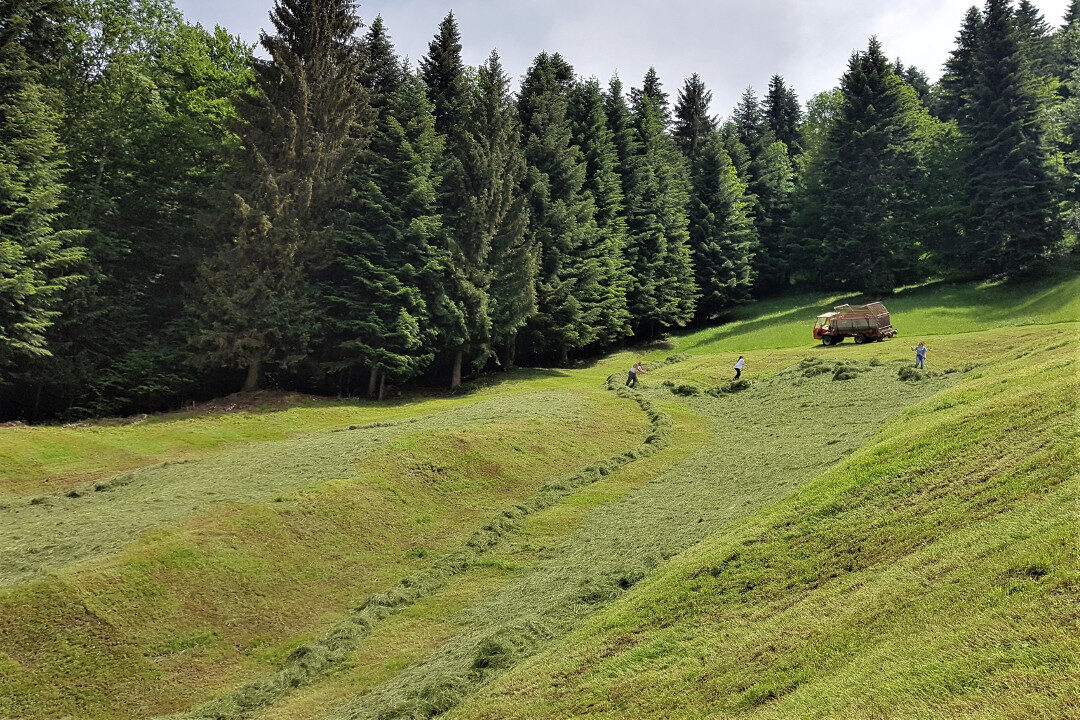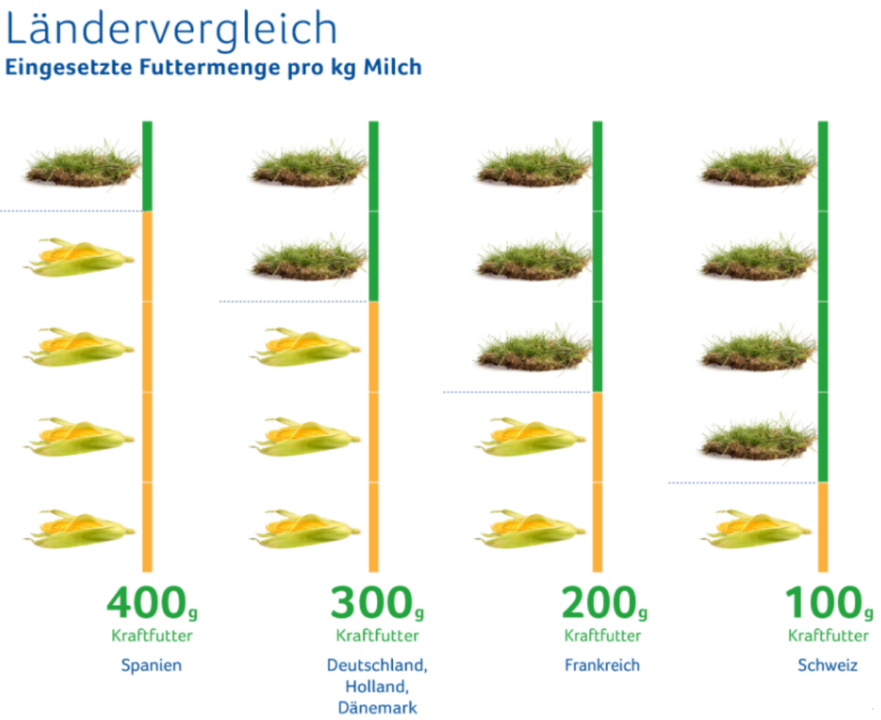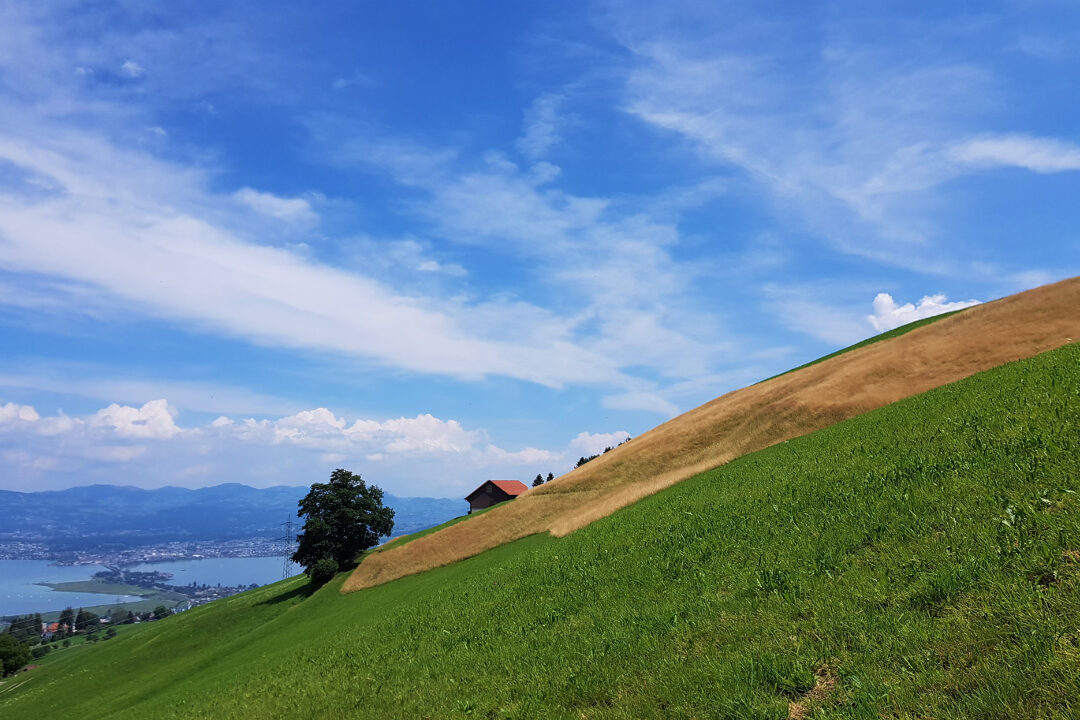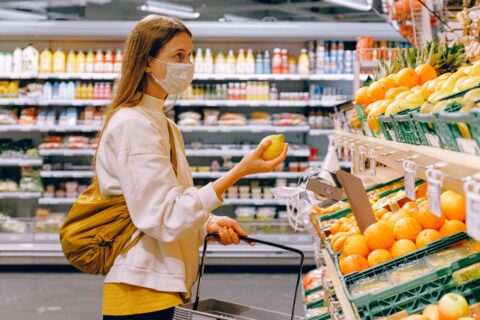Finally weekend! The lakes and rivers lure with pleasant temperatures and an ice cream should not be missing of course. While some enjoy their free time on the water, others go for a weekly walk or a hike in the mountains. Here and there they meet farming families who spend their free day haying. Especially on the steep slopes they are happy for every manpower, because the hay should be in the stable before the next rain.

More miscarriages after thunderstorm-June
Due to the numerous thunderstorms at the beginning of June 2018 – hardly a day was without rain – the farmers were only able to start the hay harvest very late. At least three successive hot sunny days are needed for the grass to dry well. This year’s delay of almost a month means a poorer hay quality: the forage becomes coarser and rougher, the protein and energy content decreases. For hay farmers, this weather pitch results in high costs, because they not only have to buy additional compensatory feed for the winter, but also have to reckon with higher veterinary costs because fertility decreases with hay quality and the risk of miscarriages increases.
Many steps to feed
In order for the cows of the hay farmers to have enough to eat even in the cold winter, the grass must be brought from the meadow to the barn. Depending on how steep the land is, other machines are used and a lot of manual work is required, which is why the whole family often helps. The video shows the individual steps from mowing to transport with the hay crane. By the way, only the first cut after winter is described as hay. There can be up to six cuts per year, depending on how fast the grass grows. The work steps are always the same:
First the grass has to be mown. Depending on the steep slope, a tractor, mower or scythe is used. To dry it faster, it is turned with a tedder. Before loading, swaths must be formed. This is done by hand or with a rake. Only then is the hay/edge loaded with a loader wagon, which then unloads it in the barn, where it is transported with a hay crane to the hay storage area, where it is dried well one last time by the hay fan.
Less concentrated feed for better milk
A cow eats up to 80 kilos of grass a day in summer. In addition, there is a small amount of concentrated feed (feed with a high concentration of nutrients), which is very low in Switzerland at around one fifth (see graph). The large proportion of high-quality grasses is due to topographical conditions: according to the Federal Statistical Office (FSO), 70% of the usable area can only be used as green space and therefore not as arable land. This is why cows are needed that can utilize the roughage (grass, hay, silage).
In many of our neighbouring countries, on the other hand, concentrated feed has become the main component of food. The reason: the more concentrated feed, the more milk the cow gives, sometimes up to 25 percent. But the quality is declining, as several studies by the Agroscope Research Station have shown: The milk of such high-performance cows has a poorer fatty acid composition and contains fewer unsaturated fatty acids. The CLA (conjugated linoleic acid) content, which is particularly good for the blood circulation system, is also significantly lower. However, not only milk but also meat is less healthy because it contains more saturated fatty acids when cows eat a lot of concentrated feed.
However, corn, soybean meal and co. not only lead to a loss in the quality of milk and meat, they also influence the pH of the pancake and the balance of bacteria in the cow’s stomach. If overdosed, it can even lead to metabolic disorders. Not to mention the environmental damage in countries like Brazil, where huge soy plantations cause problems with pesticides and soil erosion. Although the production of GMO-free soya is declining in South America, Switzerland continues to set an example, as the proportion of soya from environmentally and socially compatible production has increased from 40% to around 95% in the last six years.
In spite of all these disadvantages, the use of concentrated feed is likely to increase in importance in Switzerland as well. This is partly due to the low milk price, which has not been cost-covering for years and is partly offset by higher-performance cows. Another reason is the disappearance of small farms and the trend towards ever larger farms: The herds of cows are getting bigger and bigger, but the pastures are not growing at the same rate. Farmers must therefore make greater use of concentrated feed in order to maintain a high level of self-sufficiency.
Swissmilk’s graph shows how the feed for a litre of milk is combined in Switzerland (right) and abroad.

New cow and hay milk
The question remains as to whether the breeding of high-performance cows is sustainable at all if they require more expensive concentrated feed for the larger amount of milk and the pastureland is limited anyway. The “New Swiss Cow” interest group is taking a step in this direction by advocating a healthy cow that may be smaller, but thanks to feeding on grass and hay is also less sick and delivers better milk.
The fact is that in October 2017 “only” around 560,000 dairy cows were still grazing on Swiss meadows. This is the lowest level since the end of the 1980s (statistics from the animal traffic database TVD). However, milk production has hardly declined, which means that price policy in Switzerland also has an impact on animal feed. For Switzerland, the many steep slopes are both a curse and a blessing. Haymaking in the mountains is both exhausting and dangerous. Year after year, fatal accidents occur because tractors roll over in steep terrain or a farmer plunges off the cliff while haying. At the same time, these non-drivable slopes are important for biodiversity: part of the land is cut very late as organic hay, the soil cannot be used as arable land and the farming families work to protect the land from wildlife.

Organic hay may only be mown from 15 June, so that the plants can be seeded and the diversity of species is preserved. At the same time, however, the quality and yield of the fodder decreases, because cows prefer fresh grass.
And last but not least: For the health of the cows there is nothing better than fresh grass and hay. This not only preserves the high quality of Swiss milk, it also protects the environment. With a milk price that will hopefully cover costs in the future, the disappearance of small farms and the development of high-performance cows is to be slowed down or stopped.
The next blog article will tell you more about the hay-milk label, which is committed to sustainable milk production.








Leave a comment